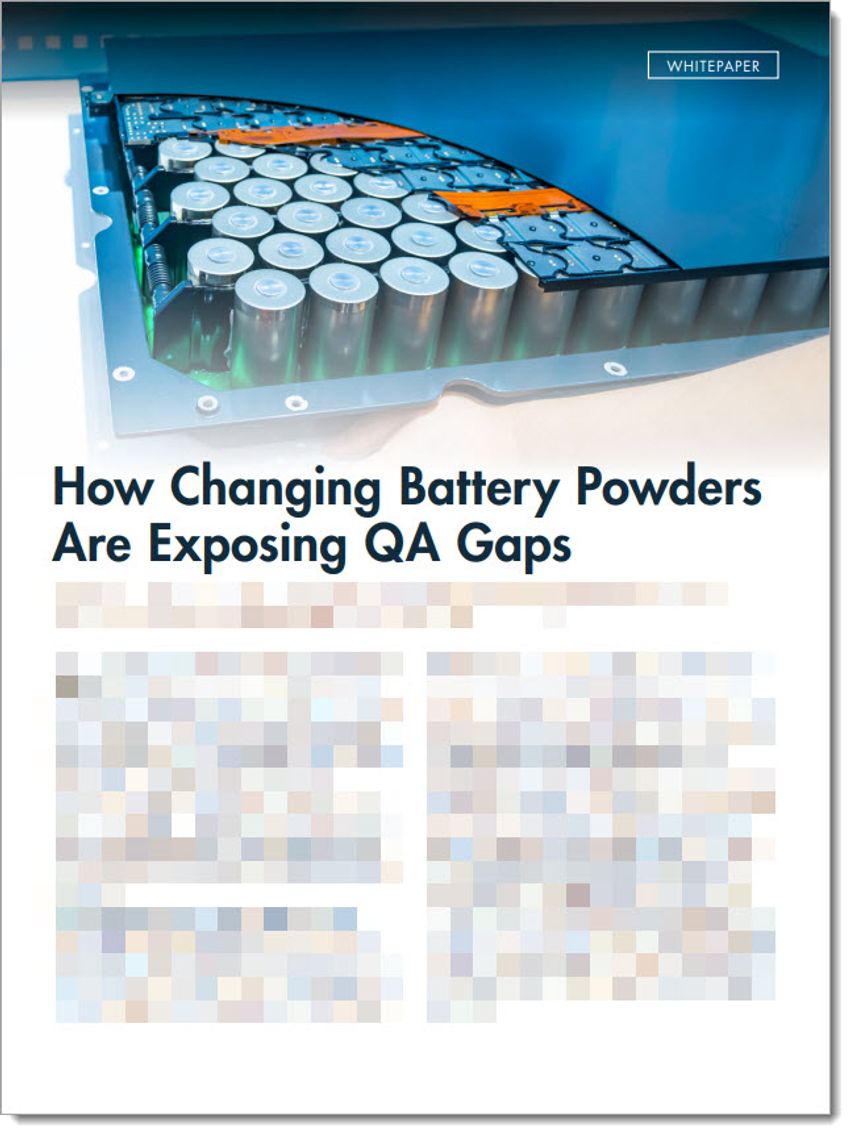How Changing Battery Powders
Are Exposing QA Gaps
Moisture, coatings, and dopants distort sulfur and carbon results. This guide shows how labs
adjust methods when powders stop behaving as expected.
As recycled inputs increase, battery powders behave
less predictably. Moisture, sulfur, and residual
coatings now appear in materials that once arrived
clean, distorting QA results. The International Energy
Agency (IEA) projects battery-recycling output will triple
by 2030, reshaping supply chains with reclaimed cathodes,
synthetic blends, and graphite from spent cells.
This guide tracks those shifts across the battery workflow. Drawing on LECO application data, it shows where
analysis drifts and how labs adapt by selecting furnaces
that match powder behavior. A final checklist summarizes
which instruments perform best for cathodes, graphite, and
black mass.
Which furnace matches your cathode powder?
Lithium iron phosphate (LFP) cathodes are now the
fastest-growing battery chemistry, according to the IEA,
dominating entry-level EVs in China and expanding rapidly into grid storage and commercial fleets. With better
thermal stability than other lithium-ion chemistries and
lower cost from eliminating cobalt, the appeal of LFP
cathodes is clear. Most are manufactured by reacting iron
salts, phosphoric acid, and a lithium source—often in the
presence of carbon to improve conductivity.
That added carbon, along with sulfur introduced
through processing or recycling, affects downstream battery performance. Industry standards now call for detailed
carbon and sulfur testing of LFP powder precursors,
typically using combustion furnaces paired with infrared detectors. But as LECO applications chemist Lauren
Heirty cautioned in a recent webinar, getting reliable
results depends on matching the furnace to the sample.
The main difference lies in how furnaces apply heat to
sample, she explained. Induction systems, such as LECO’s
CS744 instrument, heat the sample with an electromagnetic field and complete analysis in about two minutes. They
handle clean powders well but are less tolerant of challenging matrices.
WHITEPAPER
2
Resistance furnaces, such as the SC832DR, use a longer
three-minute cycle and accept larger sample masses.
They perform well with reclaimed or coated powders that
burn unevenly.
What sets induction furnaces apart is their low-end
sensitivity. The CS744 detects carbon at levels nearly nine
times lower than resistance systems, and sulfur at nearly
twice the sensitivity. This sensitivity proved essential in a
recent LECO study. Analysts spiked sulfur into LFP powders from several suppliers and saw full recovery in every
case, with no signal loss or sulfur trapped in the matrix.
Can your furnace handle doped or coated powders?
By the time cathode powders reach midstream QA, they
have been engineered for performance: layered, doped, or
surface-treated to improve electrochemical stability. But
those same features disrupt combustion, especially in induction furnaces. Rapid heating prevents coated particles
from breaking down fully. The result is partial oxidation,
poor recovery, and sulfur that escapes detection.
This problem shifts analysis to resistance furnaces such
as the SC832DR, which heat more gradually over longer
cycles. That gives coatings and dopants time to combust fully. The SC832DR also addresses sulfur detection
directly through options such as dual infrared cells—one
tuned for trace levels, the other for higher concentrations—that switch automatically as needed.
Application testing on doped lithium nickel manganese
cobalt oxide (NMC) powders, a high-energy cathode
material, demonstrated the SC832DR’s performance under
midstream conditions. For the NMC 111 sample set, sulfur
held at 0.137% with just 0.001% deviation. Carbon results
were equally stable, averaging 0.075% with the same level
of precision.
The same method carried over to LFP powders, where
sulfur content measured an order of magnitude lower.
Across two runs, values ranged from 0.0132% to 0.0163%,
with standard deviations as low as 0.0002%. Carbon averaged 1.308% with only 0.002% variation. No changes to
furnace settings or sample prep were needed.
How do you analyze black mass and recycled
graphite?
Recycled battery materials—whether graphite fines,
cathode fragments, or full-spectrum black mass—rarely
behave like their virgin counterparts. Shredding, drying,
and sorting produce unstable mixtures of carbon, metals,
binders, and residual salts. Each component burns differently. “Two samples from the same lot can act like different
materials once you dry, grind, or purge them,” said Heirty
during the company’s black mass webinar.
That variability makes baselines unreliable. Thermogravimetric analysis (TGA) is often the first tool for
mapping moisture loss, binder breakdown, and residual ash
before combustion begins. In the webinar, Heirty showed
how untreated black mass produced high moisture and
ash, distorting sulfur recovery until drying and furnace
parameters were adjusted. For feedstocks where carbon is
abundant but contamination is unknown, TGA systems
such as LECO’s TGA801 reveal where the problems start.
Graphite adds another layer to that story. Whether
synthetic, natural, or recovered, graphite anode material is
mostly carbon. But purity still varies: moisture can cling
to surfaces, while inorganics, including silicates and metal
oxides, stay behind as ash. In a recent LECO application
note using the TGA801, analysts tested several grades of
graphite and found that larger sample sizes improved trace
ash detection and repeatability. The same approach applies
when graphite is part of black mass: mass loss profiles clarify what to expect, and what needs adjusting.
Combustion methods take over where TGA leaves off.
In LECO’s black mass webinar, Heirty demonstrated how
Method validation:
four steps
LECO chemist Lauren Heirty outlined key
steps for reliable elemental analysis of
battery powders.
1. Blanks
Run the crucible and accelerants alone to set
the baseline and establish the detection limit.
2. Calibration
Use certified reference materials to anchor the
instrument response, with either a single-point
or full regression curve.
3. Second standard
Test a second sample in the working range to
confirm the calibration holds.
4. Spike recovery
Add a known mass of sulfur or carbon. Poor
recovery signals a matrix effect or method issue.
3
To learn more, visit: leco.com
the SC832DR handled both recycled graphite and mixed
black mass samples, each charged with 1 g of Com-Cat™
to drive complete combustion. Dual infrared detectors
captured both trace and elevated sulfur, while spike recovery exposed whether suppression came from the matrix
or the material. Even in high-ash, low-sulfur batches, the
instrument delivered repeatable carbon results and picked
up sulfur down to hundred-ppm levels.
Getting reliable results across the battery lifecycle
Five practices help labs stay accurate, even as powders change.
1. Match method to material
Recycled powders, doped cathodes, and virgin graphite
burn differently. Results stay accurate only when furnace
type, cycle time, and detection range reflect actual sample behavior.
2. Pair combustion with TGA
Combustion gives totals; TGA shows when those totals
appear. Together they expose trapped sulfur, lingering
moisture, and ash that a single test can miss.
3. Verify recovery
Run blanks, certified standards, and spike tests on every
batch. Built-in tools on systems such as the SC832DR and
TGA801 make the check routine and fast.
4. Automate steps
Autoloaders, barcode IDs, and linked software apply the
method the same way each time. This keeps results stable
across shifts, operators, and sample types.
5. Monitor trends
Track carbon in LFP, sulfur in black mass, and ash in graphite over time. Subtle shifts in those values can flag contamination or process drift before production is affected.
Meet the Expert
Lauren Heirty
Analytical Chemist, LECO Corporation
Lauren focuses on battery material
analysis, including recycled graphite and
black mass, and holds a degree from
Purdue University.
Battery QA Method Matching Checklist
Select the best LECO instrument for elemental analysis of today’s
cathode powders, graphite sources, and black mass.
Sample Type CS744 SC832DR TGA801
LFP cathode powder
(clean)
Best fit Not recommended Check moisture if
needed
NMC cathode powder
(doped/coated)
Risk: poor sulfur
recovery
Best fit Check moisture if
needed
Virgin synthetic
graphite
Limited recovery; use
SC832DR
Best fit Recommended for ash
profiling
Recovered graphite
(spent anode)
Use after TGA801 Best fit Profile moisture &
binder
Black mass (recycled
mix)
Not recommended Best fit Profile moisture & ash
Binder-rich slurry or
blend
Not recommended Best fit Quantify moisture and
binder loss
Moisture-sensitive
powder
Dry thoroughly before
analysis
Dry thoroughly before
analysis
Best for moisture
content
Ash-heavy residue
(metal oxides)
Best fit Requires spike
verification
Recommended for ash
profiling
Use spike recovery to confirm C/S accuracy in variable matrices. Pre-dry all samples with
significant moisture or binder content. “Ash profiling” refers to post-burn inorganic residue used
to assess sample purity.





